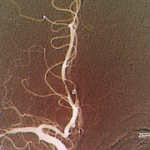 Insights from 2 Patients with Susac Syndrome
Insights from 2 Patients with Susac Syndrome
EULAR 2024 (VIENNA)—Rheumatoid arthritis, systemic lupus erythematosus (SLE) and spondyloarthritis are the bread and butter of most rheumatology practices. But every now and then, a consult doesn’t quite fit the mold—that one patient who presents with hearing loss, vision changes and/or neurologic dysfunction. When we receive consults like these, we’ve got to be at the top of our game because the stakes are high. Catching a brain, ear, eye syndrome early can change a life.

Dr. Ofir Dovrat
During a session at EULAR 2024, Tali Ofir Dovrat, MD, and Victoria Furer, MD, both rheumatologists from the Department of Rheumatology, Tel Aviv Sourasky Medical Center, Israel, described two cases of Susac syndrome. They shared their center’s experiences with these patients and provided updates on the literature.
Case 1
The first patient was a 33-year-old woman. One year prior to admission, she experienced sudden unilateral, sensorineural hearing loss. At that time, magnetic resonance imaging (MRI) of her brain was normal. She presented to the neurology service with vertigo, nausea, vomiting and recurrent sudden unilateral, sensorineural hearing loss. Shortly thereafter, she developed encephalopathy. She was confused, disoriented, couldn’t remember the names of her children and had a wide-based gait. She was afebrile, with no other systemic signs or symptoms of infection.
The patient’s laboratory tests were grossly unremarkable, with normal complete blood count, comprehensive metabolic panel, inflammatory markers, anti-nuclear antibody (ANA), extractable nuclear antigens, rheumatoid factor, anti-neutrophil cytoplasmic antibody (ANCA), and antiphospholipid antibodies (APLAs). However, her cerebrospinal fluid was abnormal, with elevated white blood cells (14 mononuclear cells/mL3) and elevated protein (125 mg/dL). Her cerebrospinal fluid glucose and opening pressure were normal. Extensive infectious tests and toxicology screens were unrevealing.
An electroencephalogram showed bilateral frontotemporal slowness—a nonspecific finding. However, the MRI of her brain showed multiple snowball lesions in the corpus callosum, cerebellum and periventricular white matter. Ophthalmologic examination showed cotton wool spots and fluorescein angiography showed bilateral branch retinal artery occlusions despite a lack of visual symptoms.
Case 2
The second patient was a 20-year-old man with a past medical history of depression. He was admitted to the emergency department with acute hearing loss, vertigo and headache. This condition was followed shortly thereafter by aphasia, confusion, paresthesia and a wide-based gait. He could not recognize his family members and had impaired memory, attention and executive function of neurologic exam. As with the first patient, his laboratory studies and infectious evaluation were normal. His cerebrospinal fluid studies were abnormal, with elevated opening pressure and protein levels (113 mg/dL).

